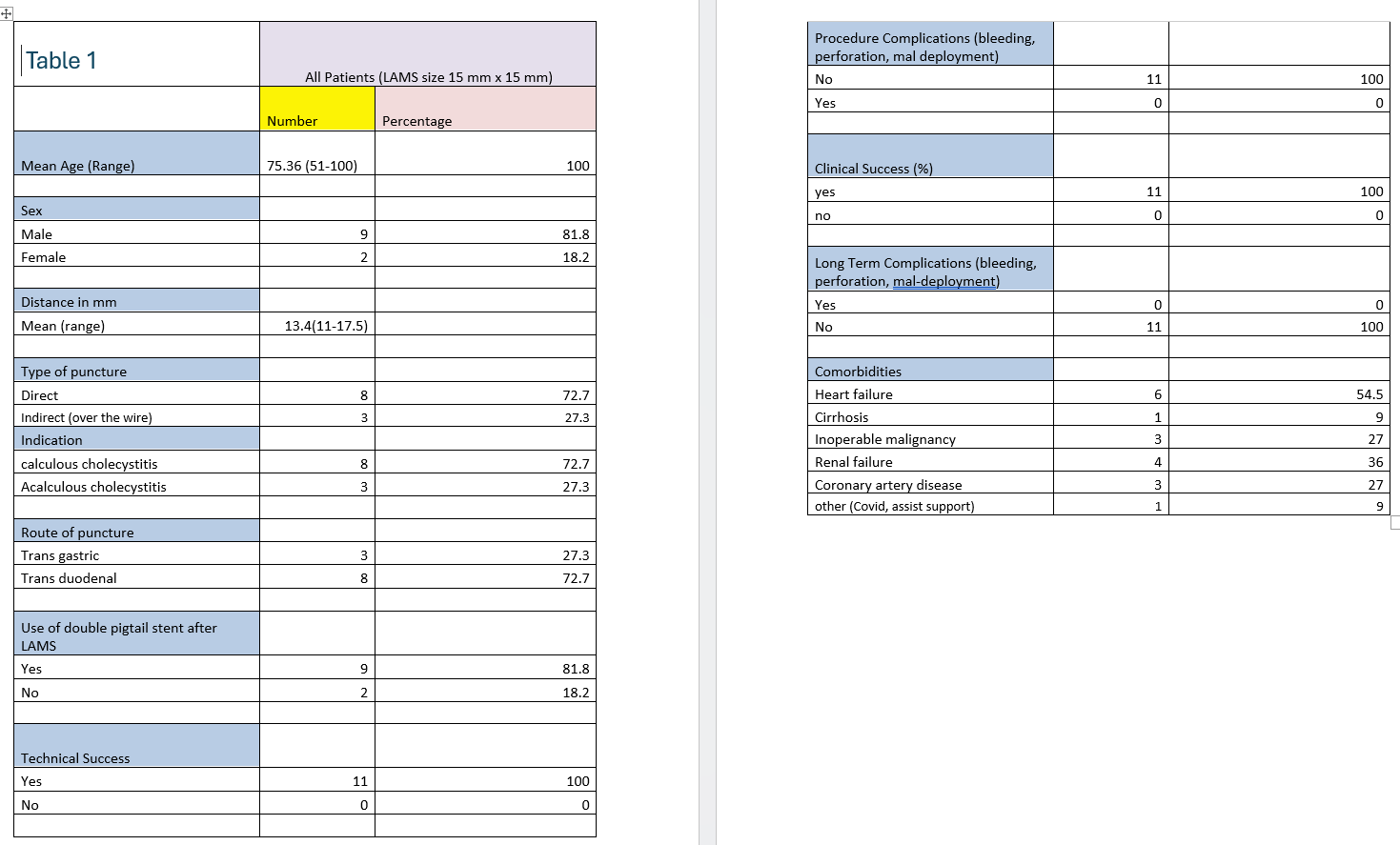Sunday Poster Session
Category: Biliary/Pancreas
P0011 - EUS-Guided Gallbladder Drainage Using Lumen Apposing Metal Stents in Cases With Gallbladder-Enteric Wall Distance > 10 mm
Sunday, October 26, 2025
3:30 PM - 7:00 PM PDT
Location: Exhibit Hall
- VK
Varun Kesar, MD
Virginia Tech Carilion School of Medicine
Roanoke, VA
Presenting Author(s)
Varun Kesar, MD1, Darius A. Jahann, MD2, Vivek Kesar, MD3, Ali Siddiqui, MD4, Paul Yeaton, MD3, Patrick Okolo, MD3, Jessica Widmer, DO5, Harshit S. Khara, MD6
1Virginia Tech Carilion School of Medicine, Roanoke, VA; 2Atrium Health Wake Forest Baptist, Winston-Salem, NC; 3CARILION CLINIC, Roanoke, VA; 4Maimonides Medical Center, Fairfax, VA; 5NYU Langone Health, Mineola, NY; 6Geisinger Health System, Danville, NJ
Introduction: Endoscopic ultrasound-guided gallbladder drainage (EUS-GBD) has emerged as a viable alternative to percutaneous transhepatic gallbladder drainage (PTGBD) and surgical cholecystectomy for acute cholecystitis in high-risk surgical patients. Conventional EUS-GBD typically targets a gallbladder in close proximity to the gastric or duodenal wall, ideally with a distance of ≤10 mm, to facilitate safe and effective stent deployment. However, anatomical variations or inflammatory changes can result in a greater distance, posing a significant technical challenge and potentially increasing the risk of adverse events.
Methods: Our aim of the study was to evaluate the technical feasibility, safety, and clinical outcomes of EUS-GBD performed using lumen apposing metal stent with 15 mm (diameter) and 15 mm saddle length in patients presenting with acute cholecystitis who are not surgical candidates with an increased gallbladder-enteric wall distance exceeding 10 mm.
Results: A total of 11 patients (Table 1) with mean age of 75 years met the inclusion criteria.. Mean gallbladder-enteric wall distance of 13.4 mm +/-1.73 mm SD. The route of puncture was trans-duodenal route N= 8 (73%) and N=3 (27%) via trans-gastric. Direct puncture was used N= 8 (73%). Calculous cholecystitis was the most common indication N=8 (73 %). Most patients have multiple comorbidities with heart failure being the most common N=6 (54.5%). Technical and clinical success was achieved in 100 percent of cases. No procedure-related mortality was observed. There were no immediate (within 7 days) or delayed complications (more than 7 days).
Discussion: EUS-GBD using LAMS 15 mm x 15 mm can be technically feasible and clinically effective even in the presence of an increased gallbladder-enteric wall distance greater than 10 mm. Further prospective studies with larger cohorts are warranted to validate these findings and establish standardized approaches for this specific patient population.

Figure: Table 1

Figure: Gall bladder drainage
Disclosures:
Varun Kesar indicated no relevant financial relationships.
Darius Jahann indicated no relevant financial relationships.
Vivek Kesar indicated no relevant financial relationships.
Ali Siddiqui indicated no relevant financial relationships.
Paul Yeaton indicated no relevant financial relationships.
Patrick Okolo indicated no relevant financial relationships.
Jessica Widmer indicated no relevant financial relationships.
Harshit Khara indicated no relevant financial relationships.
Varun Kesar, MD1, Darius A. Jahann, MD2, Vivek Kesar, MD3, Ali Siddiqui, MD4, Paul Yeaton, MD3, Patrick Okolo, MD3, Jessica Widmer, DO5, Harshit S. Khara, MD6. P0011 - EUS-Guided Gallbladder Drainage Using Lumen Apposing Metal Stents in Cases With Gallbladder-Enteric Wall Distance > 10 mm, ACG 2025 Annual Scientific Meeting Abstracts. Phoenix, AZ: American College of Gastroenterology.
1Virginia Tech Carilion School of Medicine, Roanoke, VA; 2Atrium Health Wake Forest Baptist, Winston-Salem, NC; 3CARILION CLINIC, Roanoke, VA; 4Maimonides Medical Center, Fairfax, VA; 5NYU Langone Health, Mineola, NY; 6Geisinger Health System, Danville, NJ
Introduction: Endoscopic ultrasound-guided gallbladder drainage (EUS-GBD) has emerged as a viable alternative to percutaneous transhepatic gallbladder drainage (PTGBD) and surgical cholecystectomy for acute cholecystitis in high-risk surgical patients. Conventional EUS-GBD typically targets a gallbladder in close proximity to the gastric or duodenal wall, ideally with a distance of ≤10 mm, to facilitate safe and effective stent deployment. However, anatomical variations or inflammatory changes can result in a greater distance, posing a significant technical challenge and potentially increasing the risk of adverse events.
Methods: Our aim of the study was to evaluate the technical feasibility, safety, and clinical outcomes of EUS-GBD performed using lumen apposing metal stent with 15 mm (diameter) and 15 mm saddle length in patients presenting with acute cholecystitis who are not surgical candidates with an increased gallbladder-enteric wall distance exceeding 10 mm.
Results: A total of 11 patients (Table 1) with mean age of 75 years met the inclusion criteria.. Mean gallbladder-enteric wall distance of 13.4 mm +/-1.73 mm SD. The route of puncture was trans-duodenal route N= 8 (73%) and N=3 (27%) via trans-gastric. Direct puncture was used N= 8 (73%). Calculous cholecystitis was the most common indication N=8 (73 %). Most patients have multiple comorbidities with heart failure being the most common N=6 (54.5%). Technical and clinical success was achieved in 100 percent of cases. No procedure-related mortality was observed. There were no immediate (within 7 days) or delayed complications (more than 7 days).
Discussion: EUS-GBD using LAMS 15 mm x 15 mm can be technically feasible and clinically effective even in the presence of an increased gallbladder-enteric wall distance greater than 10 mm. Further prospective studies with larger cohorts are warranted to validate these findings and establish standardized approaches for this specific patient population.

Figure: Table 1

Figure: Gall bladder drainage
Disclosures:
Varun Kesar indicated no relevant financial relationships.
Darius Jahann indicated no relevant financial relationships.
Vivek Kesar indicated no relevant financial relationships.
Ali Siddiqui indicated no relevant financial relationships.
Paul Yeaton indicated no relevant financial relationships.
Patrick Okolo indicated no relevant financial relationships.
Jessica Widmer indicated no relevant financial relationships.
Harshit Khara indicated no relevant financial relationships.
Varun Kesar, MD1, Darius A. Jahann, MD2, Vivek Kesar, MD3, Ali Siddiqui, MD4, Paul Yeaton, MD3, Patrick Okolo, MD3, Jessica Widmer, DO5, Harshit S. Khara, MD6. P0011 - EUS-Guided Gallbladder Drainage Using Lumen Apposing Metal Stents in Cases With Gallbladder-Enteric Wall Distance > 10 mm, ACG 2025 Annual Scientific Meeting Abstracts. Phoenix, AZ: American College of Gastroenterology.
